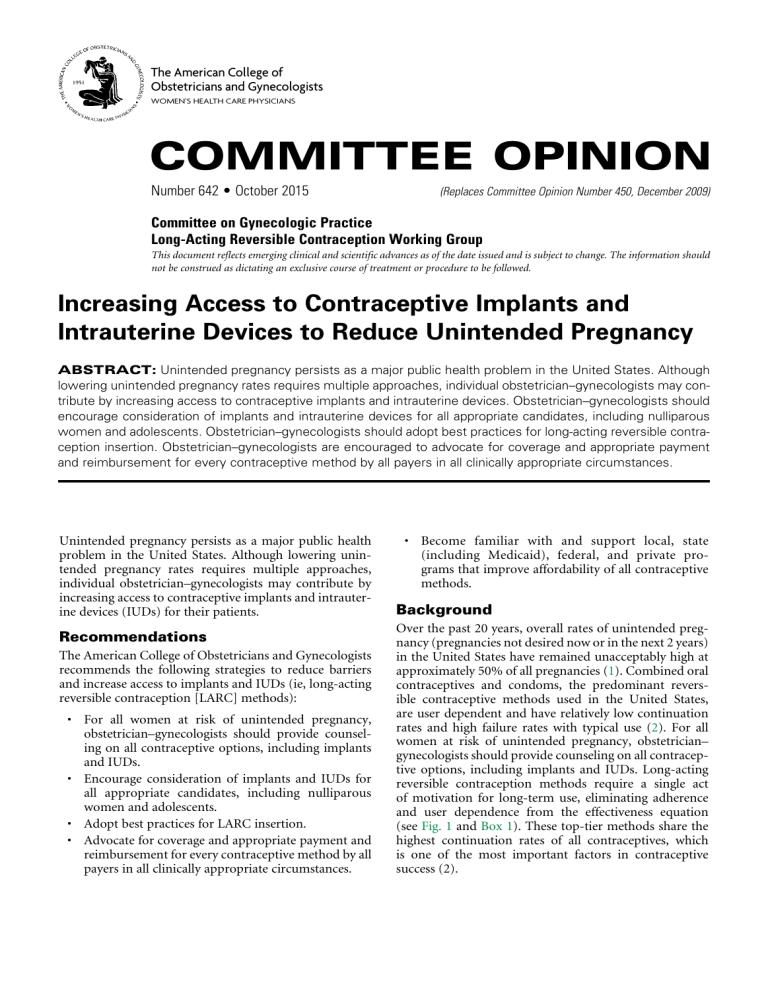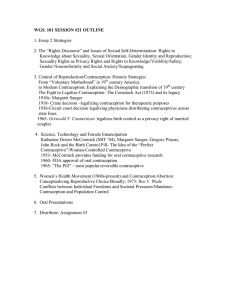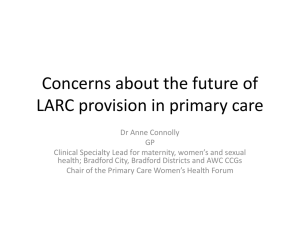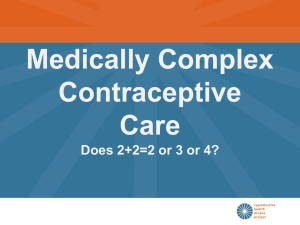COMMITTEE OPINION Committee on Gynecologic Practice Long-Acting Reversible Contraception Working Group

The American College of
Obstetricians and Gynecologists
WOMEN’S HEALTH CARE PHYSICIANS
C OMMITTEE OPINION
Number 642 • October 2015
(Replaces Committee Opinion Number 450, December 2009)
Committee on Gynecologic Practice
Long-Acting Reversible Contraception Working Group
This document reflects emerging clinical and scientific advances as of the date issued and is subject to change. The information should not be construed as dictating an exclusive course of treatment or procedure to be followed.
Increasing Access to Contraceptive Implants and
Intrauterine Devices to Reduce Unintended Pregnancy
ABSTRACT: Unintended pregnancy persists as a major public health problem in the United States. Although lowering unintended pregnancy rates requires multiple approaches, individual obstetrician–gynecologists may contribute by increasing access to contraceptive implants and intrauterine devices. Obstetrician–gynecologists should encourage consideration of implants and intrauterine devices for all appropriate candidates, including nulliparous women and adolescents. Obstetrician–gynecologists should adopt best practices for long-acting reversible contraception insertion. Obstetrician–gynecologists are encouraged to advocate for coverage and appropriate payment and reimbursement for every contraceptive method by all payers in all clinically appropriate circumstances.
Unintended pregnancy persists as a major public health problem in the United States. Although lowering unintended pregnancy rates requires multiple approaches, individual obstetrician–gynecologists may contribute by increasing access to contraceptive implants and intrauterine devices (IUDs) for their patients.
Recommendations
The American College of Obstetricians and Gynecologists recommends the following strategies to reduce barriers and increase access to implants and IUDs (ie, long-acting reversible contraception [LARC] methods):
• For all women at risk of unintended pregnancy, obstetrician–gynecologists should provide counseling on all contraceptive options, including implants and IUDs.
• Encourage consideration of implants and IUDs for all appropriate candidates, including nulliparous women and adolescents.
• Adopt best practices for LARC insertion.
• Advocate for coverage and appropriate payment and reimbursement for every contraceptive method by all payers in all clinically appropriate circumstances.
• Become familiar with and support local, state
(including Medicaid), federal, and private programs that improve affordability of all contraceptive methods.
Background
Over the past 20 years, overall rates of unintended pregnancy (pregnancies not desired now or in the next 2 years) in the United States have remained unacceptably high at
approximately 50% of all pregnancies ( 1
). Combined oral contraceptives and condoms, the predominant reversible contraceptive methods used in the United States, are user dependent and have relatively low continuation
rates and high failure rates with typical use ( 2 ). For all
women at risk of unintended pregnancy, obstetrician– gynecologists should provide counseling on all contraceptive options, including implants and IUDs. Long-acting reversible contraception methods require a single act of motivation for long-term use, eliminating adherence and user dependence from the effectiveness equation
(see
). These top-tier methods share the highest continuation rates of all contraceptives, which is one of the most important factors in contraceptive success (2).
Fig. 1.
Effectiveness of birth control methods.* Abbreviations: HIV, human immunodeficiency virus; IUD, intrauterine device; STIs, sexually transmitted infections.
*Percentage of women who will become pregnant within the first year of typical use of the method.
2 Committee Opinion No. 642
Box 1. Advantages of Long-Acting
Reversible Contraception Methods
• Effectiveness independent from coitus, user motivation, and adherence
• Highest effectiveness, continuation rates, and user satisfaction of all reversible methods
• No requirement for frequent visits for resupply
• No requirement for additional funding for consistent use once placed
• Highly cost-effective
• Reversible, with a rapid return to fertility after removal
• Few contraindications
Long-Acting Reversible Contraceptive
Methods
Currently, five LARC devices are available in the United
States: one single-rod etonogestrel implant approved for use up to 3 years and four IUDs. The copper T380A
IUD is approved for use up to 10 years. Additionally, three levonorgestrel-releasing intrauterine systems are available: two approved for use up to 3 years and one approved for use up to 5 years. Long-acting reversible contraception methods have few contraindications
(see the United States Medical Eligibility Criteria for
Contraceptive Use, 2010, available at http://www.cdc.
gov/reproductivehealth/unintendedpregnancy/usmec.
htm for detailed information on contraindications), and almost all women are appropriate candidates for the etonogestrel implant and the IUDs (
potentially high up-front costs and the need for office visits and trained obstetrician–gynecologists and other gynecologic and obstetric care providers for insertion and removal, LARC methods have advantages over other methods (see Box 1).
Long-Acting Reversible Contraception and Unintended Pregnancy
In the Contraceptive CHOICE Project, an observational clinical trial, participants received a contraceptive method of their choice at no cost after standardized counseling that emphasized method effectiveness. Several reports from this project have shown that improving access to and knowledge of LARC methods increases method uptake and may decrease unintended pregnancy, abortion, repeat abortion, and adolescent birth rates (
studies from the CHOICE Project confirm the superior- ity of LARC methods over short-acting methods; implants and IUDs were 20 times more effective than oral contraceptive pills, patches, or rings (
other studies indicates that increasing use of LARC methods can reduce rapid repeat pregnancy among adolescents and repeat abortion among women who have had an induced abortion (
Barriers to Increasing the Adoption of
Long-Acting Reversible Contraception
Approximately one half of obstetrician–gynecologists offer the implant in their practice, with lack of patient interest and lack of training cited as the most frequent
reasons for not offering this method ( 9
). Increasing familiarity with changes in practice guidelines and improvements associated with the newer LARC devices may address some obstetrician–gynecologists’ reluctance to encourage LARC use. Although obstetrician– gynecologists generally have favorable attitudes about
IUDs, they may use overly restrictive criteria to identify IUD candidates (
). Obstetrician–gynecologists should encourage consideration of implants and IUDs for all appropriate candidates, including nulliparous women
,
). Educating obstetrician– gynecologists about LARC and encouraging them to offer these methods to their patients may increase uptake because data show that women who have heard of the
IUD from their obstetrician–gynecologists are more likely to be interested in it than women who have not (
Obstetrician–gynecologists should adopt best practices for LARC insertion (see
). The convenience and subsequent high continuation rates of LARC placement immediately postpartum or after second-trimester abortion may outweigh the disadvantage of higher
IUD expulsion rates ( 14 ). There is no increased risk
of IUD expulsion with insertion immediately after a
).
Obstetrician–gynecologists are encouraged to advocate for coverage and appropriate payment and reimbursement for every contraceptive method by all payers in all clinically appropriate circumstances. Obstetrician– gynecologists should become familiar with and support
Box 2. Best Practices for Long-Acting
Reversible Contraception Insertion* ^
• Provide long-acting reversible contraception (LARC) methods the same day as requested, whenever possible, if pregnancy can reasonably be excluded.
• Offer LARC methods at the time of delivery, abortion, or dilation and curettage for miscarriage.
• Screen for sexually transmitted infections at the time of intrauterine device (IUD) insertion; if the screening test result is positive, treat the infection without removal of the IUD.
• Offer the copper IUD as the most effective method of emergency contraception.
*For more information, see U.S. selected practice recommendations for contraceptive use, 2013: adapted from the World
Health Organization selected practice recommendations for contraceptive use, 2nd edition. Division of Reproductive Health,
National Center for Chronic Disease Prevention and Health
Promotion, Centers for Disease Control and Prevention. MMWR
Recomm Rep 2013;62:1–60 .
Committee Opinion No. 642 3
local, state (including Medicaid), federal, and private programs that improve affordability of all contraceptive methods so that they can offer LARC in all clinically appropriate circumstances. Since implementation of the
Affordable Care Act, most insurance plans cover all contraceptives, including LARC methods, with no patient cost sharing. Many obstetrician–gynecologists and other gynecologic and obstetric care providers who receive federal Title X family planning funding, Planned Parenthood clinics, and Federally Qualified Health Centers offer
LARC methods at low or no cost. However, some women do not have coverage under the Affordable Care Act or do not have access to low-cost clinics and may encounter high up-front costs for an IUD or implant. Despite such costs, the implant and the IUDs are highly cost-effective,
even with relatively short-term (12–24 months) use ( 16
).
The high cost of LARC devices also presents a barrier when obstetrician–gynecologists experience difficulty in receiving appropriate reimbursement and payment for the device and insertion services from payers. The uptake of immediate postpartum LARC has been slowed by the difficulties hospitals and obstetrician–gynecologists encounter in receiving reimbursement and payment for devices and services separate from the global fee for delivery. Additionally, Medicare does not provide coverage for contraception. Payment and reimbursement policies that restrict abortion coverage can complicate billing procedures for covered contraceptive services and serve as a barrier to postabortion contraceptive access (
).
For More Information
These resources are for information only and are not meant to be comprehensive. Referral to these resources does not imply the American College of Obstetricians and Gynecologists’ endorsement of the organization, the organization’s web site, or the content of the resource. The resources may change without notice.
ACOG has identified additional resources on topics related to this document that may be helpful for obgyns, other health care providers, and patients. You may view these resources at www.acog.org/More-Info/
IncreasingLARC .
References
1. Finer LB, Zolna MR. Shifts in intended and unintended pregnancies in the United States, 2001-2008. Am J Public
Health 2014;104(suppl 1):S43–8. [ PubMed ] [ Full Text ]
2. Hatcher RA, Trussell J, Nelson AL, Cates W Jr, Kowal D,
Policar MS. Contraceptive technology. 20th rev. ed. New
York (NY): Ardent Media; 2011. ^
3. U.S. medical eligibility criteria for contraceptive use,
2010. Centers for Disease Control and Prevention (CDC).
MMWR Recomm Rep 2010;59(RR-4):1–86. [ PubMed ]
[ Full Text ]
4. Long-acting reversible contraception: implants and intrauterine devices. Practice Bulletin No. 121. American
College of Obstetricians and Gynecologists. Obstet Gynecol
2011;118:184–96. [ PubMed ] [ Obstetrics & Gynecology
5. Peipert JF, Madden T, Allsworth JE, Secura GM. Preventing unintended pregnancies by providing no-cost contraception. Obstet Gynecol 2012;120:1291–7. [ PubMed ]
[ Obstetrics & Gynecology ]
6. Winner B, Peipert JF, Zhao Q, Buckel C, Madden T,
Allsworth JE, et al. Effectiveness of long-acting reversible contraception. N Engl J Med 2012;366:1998–2007.
[ PubMed ] [ Full Text ]
7. Tocce KM, Sheeder JL, Teal SB. Rapid repeat pregnancy in adolescents: do immediate postpartum contraceptive implants make a difference? Am J Obstet Gynecol 2012;
206:481.e1–7. [ PubMed ] [ Full Text
8. Goodman S, Hendlish SK, Reeves MF, Foster-Rosales A.
Impact of immediate postabortal insertion of intrauterine contraception on repeat abortion. Contraception 2008;
78:143–8. [ PubMed ] [ Full Text ]
9. Luchowski AT, Anderson BL, Power ML, Raglan GB,
Espey E, Schulkin J. Obstetrician-gynecologists and contraception: long-acting reversible contraception practices and education. Contraception 2014;89:578–83. [ PubMed ]
[ Full Text ]
10. Luchowski AT, Anderson BL, Power ML, Raglan GB,
Espey E, Schulkin J. Obstetrician-gynecologists and contraception: practice and opinions about the use of IUDs in nulliparous women, adolescents and other patient populations. Contraception 2014;89:572–7. [ PubMed ] [ Full Text ]
11. Adolescents and long-acting reversible contraception: implants and intrauterine devices. Committee Opinion No.
539. American College of Obstetricians and Gynecologists.
Obstet Gynecol 2012;120:983–8. [ PubMed ] [ Obstetrics &
Gynecology
12. Contraception for adolescents. Committee on Adolescence.
Pediatrics 2014;134:e1244–56. [ PubMed ] [ Full Text ]
13. Fleming KL, Sokoloff A, Raine TR. Attitudes and beliefs about the intrauterine device among teenagers and young women. Contraception 2010;82:178–82. [ PubMed ] [ Full
Text
14. Okusanya BO, Oduwole O, Effa EE. Immediate postabortal insertion of intrauterine devices. Cochrane Database of
Systematic Reviews 2014, Issue 7. Art. No.: CD001777.
DOI: 10.1002/14651858.CD001777.pub4. [ PubMed ] [ Full
Text
15. Bednarek PH, Creinin MD, Reeves MF, Cwiak C, Espey E,
Jensen JT. Immediate versus delayed IUD insertion after uterine aspiration. Post-Aspiration IUD Randomization
(PAIR) Study Trial Group. N Engl J Med 2011;364:
2208–17. [ PubMed ] [ Full Text ]
16. Foster DG, Rostovtseva DP, Brindis CD, Biggs MA, Hulett
D, Darney PD. Cost savings from the provision of specific methods of contraception in a publicly funded program.
Am J Public Health 2009;99:446–51. [ PubMed ] [ Full Text ]
17. Thompson KM, Speidel JJ, Saporta V, Waxman NJ, Harper
CC. Contraceptive policies affect post-abortion provision of long-acting reversible contraception. Contraception 2011;
83:41–7. [ PubMed ] [ Full Text ]
4 Committee Opinion No. 642
Copyright October 2015 by the American College of Obstetricians and
Gynecologists, 409 12th Street, SW, PO Box 96920, Washington, DC
20090-6920. All rights reserved.
ISSN 1074-861X
Increasing access to contraceptive implants and intrauterine devices to reduce unintended pregnancy. Committee Opinion No. 642.
American College of Obstetricians and Gynecologists. Obstet
Gynecol 2015;126:e44–8.
Committee Opinion No. 642 5





